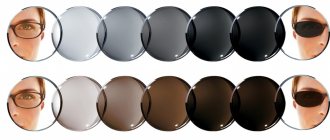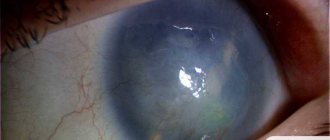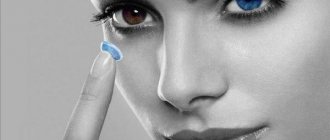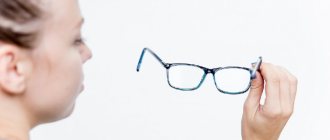The human organ of vision is the most important element of perception. The eyes not only fulfill their main purpose, but also make it possible to enjoy architectural masterpieces and breathtaking landscapes. However, under the influence of negative factors, their severity begins to decline, which negatively affects professional activities and everyday life. The solution to this problem will be glasses. The main thing is to choose them correctly. Otherwise, you will not help your eyes, but will cause additional harm.
Selection of glasses for vision
If you suspect deviations in refraction, you should immediately visit an ophthalmologist. He will conduct a detailed diagnosis, determine the diagnosis and advise which product to buy. Visual acuity testing is usually carried out using the Sivtsev table.
It is a large poster with letters of the Russian alphabet on it. The lower the line of characters, the smaller the font. The patient is positioned at a distance of five meters from the table. Each eye is checked in turn. With one eye closed, name the letters that the ophthalmologist points to. This is a fast and effective method for determining the optical characteristics of the organ of vision.
If eye acuity differs from unity, a second test is carried out, but using a corrective lens. The doctor sequentially selects the eyepiece first for the left eye, then for the right eye. The final stage of the procedure is a vision test. The indicator in the lenses must be within one.
To obtain accurate data, it is additionally possible to conduct an examination of the fundus and computer diagnostics of refraction, which will help to detect pathological processes in the visual apparatus. Based on the test results, you can choose lenses more correctly to achieve maximum therapeutic effect.
How to select glasses for vision correction?
Trial frames are popular products used in private and public medical institutions. Testing vision and selecting optical devices is a process that requires professionalism and knowledge. You need to trust it to specialists. The right glasses improve vision and improve a person's quality of life.
The selection of optical instruments using trial frames is carried out in several stages:
- visiting an ophthalmology clinic
- conducting a full examination, during which the doctor uses a device to subjectively determine refraction. A variety of lenses are inserted into the frame. The necessary correction is identified. The patient feels comfortable during the manipulations
- the doctor writes a prescription for glasses based on the individual characteristics of the patient
Selecting glasses using trial frames is a very popular method. It is used by ophthalmologists at medical institutions specializing in vision correction. By choosing advanced techniques, patients make the right choice. Experts select the ideal glasses for adults and children to help preserve and improve vision!
How different diopter levels affect the choice
Visual acuity in the left and right eyes is not always identical. Such situations require a more thorough examination. In order not to make a mistake with the choice of lenses, you will first need an eyepiece for one eye, then for the other. To do this, the patient closes the right (left) eye and the doctor adjusts the optics until vision reaches maximum acuity. Then the manipulations are repeated with the second eye.
If the deviation is insignificant, it is allowed to use the same eyepieces. In this case, the ophthalmologist relies on the patient’s personal feelings. The product should not cause discomfort or pain.
If the difference is significant, then a complex recipe is drawn up, in which the parameters for each eye are indicated through a line. In such situations, ready-made glasses sold in optical stores will not be suitable. It is necessary to order the creation of an individual model in accordance with the indicators indicated in the recipe.
| Differences in visual acuity may signal the development of ophthalmic pathologies, for example, glaucoma, cataracts, retinal detachment. |
Return to contents
Where to check visual acuity
The first thing to do is to check your visual acuity and, as a result, get a prescription from the doctor. You can check your vision: using tests on the Internet (this is not recommended by experts; in any case, you will have to go to the doctor for a prescription); at an ophthalmologist in a clinic; in the optometrist's office in any professional optical salon.
Yes, using the Internet you can try to diagnose yourself, print out special tables for checking your vision. But these results can relatively indicate the presence of a vision problem and nothing more. Remember, the official diagnosis can only be determined and confirmed by a professional doctor who will write a prescription for glasses. They can then be purchased at any optical store.
Content:
- Where to check visual acuity
- How to prepare for the procedure
- Correct selection of glasses
- Prescription registration
Choosing spectacle lenses
The most important thing when buying corrective optics is to choose the right eyepieces. Yes, the doctor prescribes the basic parameters in the prescription. But everything else falls on the shoulders (or bridge of the nose) of the future owner of the glasses. Experienced employees of specialized salons will help you make your choice.
They will talk about the advantages and disadvantages of a particular model. When choosing optics, it is important to pay attention to the manufacturer, frame material, appearance, type of lens coating, and refractive index.
Frame materials
The weight of the product, its appearance and service life depend on the choice of raw materials from which the frame is made.
Plastics
Most often, the following types of material are used to create frames:
- Cellulose acetate. This is the leader among all types of raw materials used for the manufacture of frames. Milled frames are popular because they allow you to create any shape and color. There is also a demand for “multilayer” models, in which several layers of cellulose acetate of different colors are used. Such products have a high level of flexibility;
- Kevlar. The most durable plastic, it is used to create frames for sunglasses and medical glasses. When producing raw materials, aramid fibers are added to polyamide, which is widely used for the manufacture of body armor. Kevlar is also used to make masks for various sports;
- Optil. Created on the basis of epoxy resins. 20% lighter than cellulose acetate. The exclusive right to raw materials belongs to Safilo Corporation. Most often, optical frames are used to create frames for sports glasses. The raw material has unique decorative characteristics; it is easy to “embed” stones, pieces of fabric, etc. into it;
- Polyamide. Synthetic material with a high degree of strength. Products made from it are light in weight and have good flexibility. Raw materials are often used to create sports optics;
- Carbon fiber. A composite product consisting of carbohydrate fibers joined together with epoxy resins. The raw materials have a high degree of strength. It is used to create premium products;
- NXT. Polymer with excellent optical and mechanical properties. It has high impact resistance and shape memory effect. Tolerates exposure to chemicals well. The raw materials do not react to UV rays and do not come into contact with the skin. Also, the material is absolutely transparent, so it does not hide the owner’s face, but emphasizes his sophistication.
Return to contents
Metals and alloys
To create such frames, the following materials are used:
- Copper alloys. The very first metal mastered by mankind. It is divided into several subtypes: brass, bronze, copper-nickel alloy. The first option is extremely rarely used for making frames, since brass is prone to corrosion. Bronze is used to create inexpensive products. Bronze48 alloy is made from tin bronze with minor additions of nickel and zinc. Most often it is used for temples and bridges for the bridge of the nose. Nickel silver has a silvery tint. In addition to copper, the alloy contains nickel. The material can provoke an allergic reaction, so it is most often used to make cheap frames. Blanka Z, an alloy developed specifically for the optical industry. It is an improved version of nickel silver. Resistant to corrosion, used to create expensive products;
- Stainless steel. The material is very popular among manufacturers. It is an alloy based on iron. Chromium gives stainless properties; it must contain at least 10.5%. The steel is resistant to corrosion, acids and high temperatures. You can use it to create lightweight frames that will have a low price;
- Aluminum. The material is considered an ideal option for creating a frame for glasses. It is rust resistant, biocompatible and lightweight. Disadvantages include low strength and weak elasticity. Most often, aluminum is used to create thick frames;
- Titanium. The material does not contain nickel and is hypoallergenic. It is not subject to corrosion, has low weight and good elasticity. However, over time, the material becomes brittle and can break easily;
- Gold. Pure precious metal is never used because it has a decent weight and has a high price tag. People prone to allergic reactions should opt for products made of 585 gold; it does not require a protective coating and is not subject to corrosion. The color of the metal depends on the composition of the alloy. If there is more copper in it, then the product will be red. The disadvantages of solid gold frames include their heavy weight and exorbitant price tag. The material does not have high elasticity, so it is easily deformed. But, of course, in aesthetics he has no equal.
Natural materials
In addition to metal and plastic, leather, wood and horn are used to create frames. An ideal option for people who value not only comfort, but also the uniqueness of things.
Types of glasses frames
When choosing a corrective product, you should pay attention to the shape of the frame. Some types of glasses frames are suitable only for a few people.
"Aviator"
The most popular variety, which has not lost its relevance over the years. Aviator glasses were first used in 1930, they were developed specifically for US Air Force pilots. The model gained the greatest popularity in 1969, after the release of the film “Easy Rider”.
"Wayfarer"
The first sunglasses with trapezoidal lenses appeared on the market in 1952. An avalanche of popularity hit them in 1961, when the film “Breakfast at Tiffany’s” was released, where the incomparable Audrey Hepburn shone in the Wayfarers.
"The Lennons"
Today, this concept hides small, round metal glasses. They got their name thanks to John Lennon (who would doubt it). In the 70s, people tried to imitate their idol in everything, including sweeping glasses off the shelves, like those of their favorite artist.
However, for those whose childhood was in the 90s, such optics are primarily associated with Harry Potter. The hero managed to make simple glasses extremely popular and teenagers suffering from poor eyesight and wearing similar eyepieces no longer considered themselves outsiders.
"Cat's eye" and "butterfly"
The most feminine forms of glasses among all models. They first appeared on the market in the 50s. It is believed that Christian Dior himself was involved in their development. The most popular manufacturer of such optics is Tura. Consumers sometimes confuse these two models, believing that they are different forms. Yes, there are minor differences between them. But most often, “cat's eye” and “butterfly” act as synonymous definitions.
"Panto"
Translated from Greek it means “all”. The glasses provide full visibility due to their straight shape. The lower part of the products is round, and the upper part is straight. Eyepieces first appeared on the market in the 1930s. The world fell in love with panto in the 1980s, with such popular personalities as Woody Allen and Johnny Depp becoming fans of the form.
"Dragonfly"
Huge glasses, reminiscent of insect eyes, found greatest demand in the 70s. The main fan of the “dragonfly” was the widow of US President John F. Kennedy, Jackie Onassis.
"Clubmaster"
Their second name is “browliners”. These are glasses in a combined frame with round-shaped light openings. The upper part of the products is reinforced with plastic “arcs”, which create the effect of double eyebrows. The most famous admirer of the “clubmaster” is the fighter for black rights Malcolm X.
"Lolita"
The unusual name was tightly “stuck” to the heart-shaped glasses after the release of the film “Lolita” by Stanley Kubrick. However, what's interesting. The main character did not use such an accessory. But when creating the advertising poster, the performer of the central role was dressed in “Lolita”. Since 2008, a similar model began to be associated with the name of Madonna, who chose such glasses for her world tour.
Choosing glasses depending on your face shape
Corrective optics not only help correct existing vision problems, but are also a stylish accessory. With their help, you can create a unique image and emphasize your individuality. For this reason, it is extremely important to know how to choose glasses based on your facial structure.
There are several types of human “face”:
- Square. Oval and rounded frames look good;
- Round face. Strict glasses in a square frame will look great. In this case, the shade of the frame must be chosen in a saturated color so that it stands out clearly on the face;
- Oval type. The lucky owners of such a face can choose any model, everything looks good on them. The only limitation is that you should not buy glasses that are too bulky;
- Heart-shaped look. A universal face type that is also suitable for all models. However, there is a small recommendation for choosing frames: choose products with a minimum number of decorative elements;
- Elongated shape. For such a face, all optical models with large frames and lenses are well suited. It is better to immediately put aside narrow and miniature options.
Return to contents
Selection of frames depending on color type
Just as the year is divided into seasons, so people are classified into “spring,” “autumn,” “summer,” and “winter.” The first two options belong to the warm color type, the second to the cold one. When choosing frames, you should take this point into account and adhere to some rules:
- For “spring” people, you should take a closer look at a frame in a light beige, soft blue or linden shade. A bright red frame and dark beige would also look good. The color should not be too saturated. A person of spring type will suit thin frames made of metal with gold plating;
- For an autumn type of appearance, you need to choose warm and rich colors. Of course, the owner of fair skin and red hair will suit slightly different shades than a brunette. Frames of brown, beige or golden-honey color look neutral. It is appropriate to purchase products in a green palette. Copper and gold colors are ideal for a metal frame;
- “Summer” people are strongly advised not to buy an orange frame. For those with fair skin, pastel colors are suitable; dark-skinned people should take a closer look at a rich color, for example, linden or purple;
- Bright and cold shades are well suited for a winter type of appearance. The ideal option is black, but it is better to avoid orange. Because a “winter” person will look tired in it. For metal frames, you should choose a silver color.
Interpupillary distance measurement
The main purpose of glasses is to correct refractive error. This is only possible if the product is selected correctly. In the prescription that the ophthalmologist gives you, a separate line indicates the distance between the pupils. The parameter shows the distance between the centers of the holes in the iris, measured in millimeters.
Finished eyepieces have their own optical center; it should fall exactly in the middle of the eye. This is the only way to achieve complete vision correction. If the center-to-center distance is specified incorrectly, there is a shift to one side, and a prism effect appears. In other words, the picture received from different eyes is combined into one whole with great effort. As a result, the patient complains of discomfort, headaches and pain.
You can measure the distance in a clinic or at home. The most accurate results are obtained after a procedure using a device called a pupillometer. The device also indicates how asymmetrically the eye is located in relation to the bridge of the nose. To carry out diagnostics, it is important to place the face in the correct position in the pupillometer. The upper part rests on the forehead, the device is fixed on the bridge of the nose.
| The patient needs to focus on the bright mark in the lenses. At this time, the doctor takes the necessary measurements. The main advantage of the device is that it allows the procedure to be carried out even in patients with one eye or in the presence of binocular deviations. |
Interpupillary distance is measured using a ruler at a distance of forty centimeters. If glasses for myopia are chosen, the patient needs to focus his gaze on the tip of the doctor’s nose. Using the left eye, the doctor measures the distance from the center of the pupil of the patient’s right eye to the middle of the bridge of the nose. Then manipulations are carried out for the left eye. The technique produces monocular indicators. The information obtained helps to identify asymmetries.
The distance is measured in the same way when choosing optics for long distances. Only in this case does the patient need to focus his gaze on an object located behind the ophthalmologist’s shoulder. The difference in interpupillary distances for myopia and hypermetropia is several millimeters.
Research methodology for selecting glasses
Description
Before moving on to individual examples of glasses selection, it is appropriate to dwell on the general methodology for studying people who need glasses. Typically, such persons come with complaints of poor vision, certain difficulties and pain associated with working at close range. In these cases, the doctor will primarily be interested in the patient’s visual acuity and refraction.
Determination of visual acuity
usually not performed immediately after the subject enters the doctor's office. It is necessary to give it the opportunity to adapt to the lighting of the room.
Examination of the conjunctiva of the eyelids and transitional folds does not need to be done before determining visual acuity. Eversion of the upper eyelid always causes slight lacrimation and conjunctival hyperemia. You should also not examine the cornea, iris, pupil, and especially the fundus. All these points can make it difficult to subsequently determine true visual acuity.
Usually visual acuity
determined simultaneously with the determination of refraction. Refraction and its degree can be determined subjectively and objectively.
It is more convenient to begin the study using the subjective method, since with this method refraction is determined along with visual acuity. This method is entirely based on the testimony of the subject. Therefore, some errors are always possible here, which may depend on the patient’s lack of attention during the study or on his misunderstanding of what is required of him, or, most often, on reasons beyond the patient’s control, for example, a spasm of accommodation. An accurate determination of refraction is usually possible by an objective method that the doctor uses without requiring any testimony from the patient (skiascopy, refractometry, etc.). Hence it is obvious that any subjective study must necessarily be verified by determining refraction in an objective way; in the same way, an objective study of refraction, if it is carried out in the first place, requires verification of its results by a subjective method (it often happens that the subject cannot wear the glasses assigned to him according to the data of the objective study).
Subjective method
The definition of refraction is set out below in the relevant sections on the selection of glasses.
Of the objective methods for determining refraction, skiascopy or shadow testing should be given first place. Skiascopy was proposed by the French doctor Cuignet in 1873 (V.P. Odintsov. Eye diseases, 1938, p. 96). The method is as follows. A flat mirror reflects light from a lamp standing to the left of the subject and illuminates the pupil, as is done during ophthalmoscopy: the pupil will glow with a uniform red light. When a flat mirror is rotated around its vertical axis from right to left or left to right, a shadow appears in the pupil at one edge, which, with further rotation of the mirror, occupies the entire area of the pupil. The movement of the shadow along the pupil in the same direction in which the mirror is turned, or in the opposite direction to the movement of the mirror, depends on the refraction of the eye being examined and on the distance between the eye of the observer and the eye of the subject. If we change the refraction of the eye being examined by placing glasses from a set on it, or change the distance between the doctor’s eye and the patient’s eye, then the shadow in the pupil will also change. At first it will become less sharp, then it will almost completely disappear, and then it will reappear, but on the other side. If the shadow moved along the pupil in the same direction as the mirror, now it will appear from the opposite edge of the pupil and will move along the pupil in the opposite direction. Skiascopy
- a simple and fairly accurate method that allows you to determine refraction with an accuracy of 0.5-0.25 D, which does not require complex instruments. Usually, every ophthalmologist has on hand everything that is needed for skiascopy, i.e. a skiascope (flat mirror), a lamp and a set of optical glasses or, better yet, skiascope rulers, which contain a number of convex and concave glasses of varying strengths. The ruler is given to the subject, and he moves it up or down in front of his eye as directed by the doctor, marking the glass at which the shadow in the pupil disappears; at this moment the doctor is at a distance from the further point of view of the subject being examined. The basic rule of skiascopy is that when the observer’s eye is at a further point of clear vision of the eye being examined, a shadow in the pupil does not appear with slight movements of the mirror. Thus, by placing glasses on the eyes of each subject we are making artificially myopic. This is due to the fact that only in myopes the further point of clear vision is in front of the eye, at a finite distance, and only under this condition can the researcher position himself with a skiascope in front of the eye, illuminate the patient’s pupil and, by neutralizing the shadow with glasses, record the moment of disappearance of the shadow in the patient’s pupil. In practice, such a moment is almost impossible to catch: therefore, the doctor notes the moment when the shadow in the pupil changes its direction, and stops at the previous glass, in which the shadow had a direction characteristic of the refraction being determined.
If, with a flat mirror, the shadow moves in the direction opposite to the movement of the skiascope, myopia of more than 1.0 D is diagnosed. If the shadow moves in the same direction as the mirror, hyperopia, emmetropia or myopia of less than 1.0 D occurs. The study is performed at a distance of 1 m, since this is most convenient for skiascopy, but precisely at this point (1 m in front of the eye) there is a further point of clear vision for the subject with myopia of 1.0 D. Whenever we neutralize a shadow during skiascopy, we create in the subject myopia of 1.0 D. With higher myopia, by attaching negative lenses, we reduce it to 1.0 D, and with hyperopia, by attaching positive lenses to the eye, we increase the refraction to myopia of 1.0 D. In the first case, we did not correct by 1.0 D of the entire existing myopia, so 1.0 D must be added to the found glass; in the second case, hyperopia was recorrected by 1.0 D, so the found glass must be reduced by 1.0 D to determine the true refraction. Therefore, in order to select a true glass that corrects the refraction of the eye under study, it is necessary to add - 1.0 D to the found glass, i.e., a unit with a minus sign.
Example 1. During skiascopy at a distance of 1 m, it was found that the glass neutralizing the shadow is 5.0 D; true glass - 5.0 D + + (-1.0 D) = -5.0 D - 1.0 D = -6.0 D. Refraction - myopia of 6.0 D. Example 2. With skiascopy at a distance of 1 m found glass + 3.0 D; true glass: + 3.0 D + (-1.0 D) = + 3.0 D -1.0 D = = + 2.0 D. Refraction - hyperopia of 2.0 D.
Example 3. During skiascopy, glass + 1.0 D was found at a distance of 1 m; true glass: + 1.0 D + (-1.0 D) = 0. Refraction is emmetropic.
Skiascopy is also applicable for astigmatism.
We can rotate the skiascope from right to left and back along the horizontal meridian of the eye or from top to bottom and back along the vertical meridian. If shadows of the same direction and the same saturation are observed in both meridians of the eye, astigmatism is excluded. If the shadows have different directions, that is, in one meridian the shadow goes in the direction of movement of the mirror, and in the other meridian in the opposite direction, or the shadows in both meridians, although of the same direction, but of different saturation, then there is astigmatism. In such cases, refraction is determined in each main meridian separately; First, refraction is determined in the horizontal meridian, and then in the vertical; The research technique is the same as for spherical refraction. If the main meridians are located not vertically and horizontally, but in an oblique direction, then when the mirror moves, the oblique direction of the shadow is also noted, for example, when the mirror moves from right to left, the shadow will go from top right to bottom to left. Applying this direction, neutralizing glass is selected.
Hello! My name is Michael Richardson. I am 83 years old and my vision is perfect! I want to share with you a reliable and proven method that will help you restore your vision.
The exact direction of the two main astigmatic meridians is established during a subjective examination of the patient, according to his indications.
Skiascopy
is necessary for every determination of refraction, and the ophthalmologist must be fluent in this method. If the doctor begins the study of refraction with skiascopy, then the results of preliminary skiascopy allow him to confidently proceed to the subjective determination of refraction by applying lenses from the kit to the eye.
Sometimes only a preliminary qualitative determination of refraction
, i.e., determining only its character by the direction of movement of the shadow and by its density, in order to accurately apply the subjective method in the future, and then check the data of the subjective determination using the skiascopic method.
You can begin the study of refraction with a subjective study, and then apply verification of the obtained data by skiascopy or some other method of objective study.
In the tasks presented in the following sections, for convenience of presentation, data are first given for determining refraction by a subjective method, i.e., with glasses, and then with skiascopy data, although in most cases patients were examined first with skiascopy and then with glasses.
Is it possible to perform skiascopy with a concave mirror? i.e., with an ophthalmoscope, which examines the fundus of the eye, but you need to know that with a concave mirror, the opposite relationships are obtained, i.e., with myopia, the shadow moves in the direction of the same name as the movements of the mirror, and with hypermetropia - in the opposite direction.
In addition, you need to know that when skiascopy with a concave mirror, it is necessary to make a correction for the focal length of the concave mirror, since the source of illumination in this case will not be the surface of the mirror, but the air image of the illuminator flame located at its focus.
For example, if the focal length of the mirror is 15 cm, then in order to make a correction for a distance of 100 cm, i.e., 1 m, you actually need to skiascope from a distance of 115 cm (100 cm + 15 cm).
It is preferable to skiascopy with a flat mirror, since when the pupil is illuminated by a concave mirror, a more concentrated beam of light enters the eye and the pupil narrows more strongly than with a flat mirror, which makes skiascopy more difficult. Skiascoping is best done with wide pupils.
It is also worth mentioning the method of objectively studying refraction using very precise instruments - refractometers
. The appearance of these devices significantly simplified and clarified the determination of eye refraction. With their help, you can determine refraction with an accuracy of 0.25 D. The main advantages of these devices are ease of use and speed of obtaining results. Ocular refractometers are currently manufactured in the Soviet Union.
It was said above that when selecting glasses, it is necessary to pay special attention to ensuring that the optical centers of the lenses are opposite the centers of the pupils. For this purpose, you need to be able to accurately determine the distance between the centers of the pupils and indicate it in your glasses prescription. Incorrect centering of the glasses, especially with high refractive power, can cause a noticeable prismatic effect of the glasses and create conditions for excessive tension in the eye muscles. In all cases, when determining the distance between the centers of the pupils, the condition must be met that the visual axes of the eyes are set for distance, that is, they are parallel.
The simplest and most commonly used method
consists of measuring the distance between the centers of the pupils with a millimeter ruler: the patient is seated opposite the doctor at a distance of 25-30 cm and forced to look at some distant object over the examiner’s head; the latter places the indicated ruler horizontally to the bridge of the nose of the subject and uses it to measure the distance between the centers of the pupils. Measuring the distance between the centers of the pupils can be replaced by measuring the distance from the outer edge of the cornea of one eye to the inner edge of the cornea of the other eye. Since the pupils of the eye are placed in the middle of the iris, then, obviously, the distance between the edges of the corneas will correspond to the distance between the centers of the pupils. For close-up work, for example, for reading, the distance between the centers of the pupils must be reduced by 2-3 mm.
This method is unreliable and inaccurate, since, firstly, there is no confidence in the parallelism of the visual axes of the eyes (the subject can involuntarily shift his gaze to a closer object), and secondly, when measuring, the ruler lies on the bridge of the nose at a distance of 10-12 mm from the corneas, which causes error due to parallax. To avoid this mistake, it is recommended to install the ruler monocularly and, closing one or the other eye, fix the patient’s opposite eye.
The most advanced are modern distance meters between the centers of the pupils, which are designed in compliance with all the necessary conditions of devices intended for this purpose. This includes a pupillary distance meter manufactured in the Soviet Union.
The device is designed to determine the distance between the middle of the nose bridge and the centers of the pupils of the eyes. The sum of these distances, measured on the scales of the device, gives the total distance between the pupils of the eyes, which is determined for distance vision.
—
Article from the book: Guide to selecting glasses | Galkin N.N.
Glasses prescription
After a detailed diagnosis, the doctor writes a prescription containing the following information:
- Patient information;
- Lens optical power;
- Distance between pupils;
- What is the product intended for?
| Sometimes doctors indicate additional parameters. Never throw away the recipe! You will need it so that in the future you can compare how visual acuity has changed over a certain period of time. |
Return to contents
Determining Addition and Recipe Parameters
As we have discussed in this series of articles, subjective refractometry algorithms may vary between optometrists and may be determined by patient characteristics. Accurate and correct determination of refractive error and optical power for distance vision correction is very important, since it creates a solid basis for prescribing presbyopia correction. The final lens power is a combination of the distance power and the near power addition.
Always explain the procedure to the patient; let him know what to expect. Be precise and use clear language, and be able to explain the test in terms that the patient can understand. Below is a possible version of the refractometry algorithm:
- Assessment of visual function/visual acuity at distance and near.
- Subjective assessment of refraction in distance vision.
- Determination of binocular balance, if necessary.
- Binocular addition.
- Setting up a trial frame for close up.
- Rechecking vision/visual acuity.
- Measurement of the amplitude of accommodation, if necessary (Table 2).
- Addition assessment for near/prescription.
- Determination of the final optical power of reading lenses.
Table 2 Approximate amplitude of accommodation relative to age
Correction rules for farsightedness
Hypermetropia is a pathology in which a person can clearly distinguish objects located at a distance, but cannot see nearby objects. Most often, the cause of the development of the disease is a shortened eyeball. The disease is diagnosed in children and adults.
To correct hypermetropia, special optics are used, which must be selected by a specialist. The choice of products to combat farsightedness has a number of nuances:
- Glasses only correct refraction, but have a therapeutic effect. In other words, they are able to “mask” the disease rather than cure it. Their purpose is to relieve a person from the discomfort that arises due to poor vision;
- The product should be worn on a permanent basis only if a severe form of farsightedness is detected and the patient is unable to see anything without auxiliary optics;
- When selecting, take into account the distance at which you are working with small elements. Depending on this, lenses are divided into strong or weak;
- The distance between the eyepiece and the organ of vision should be about twelve millimeters. This is the optimal indicator, otherwise glasses can harm your health;
- If you plan to wear the product constantly, then purchase models with progressive or bifocal lenses. Optical parameters change more slowly in them. In progressive eyepieces they increase from top to bottom. In bifocal products, the lens is divided into two parts (one for near vision, the second for distant vision);
- In order not to make a mistake in choosing a model, you need to wear glasses for at least half an hour;
- For a certain type of activity, products with different optical powers are prescribed. They change clothes when changing classes.
From the video you will learn how to choose glasses for vision.
GLASSES – spectacle correction of vision
GLASSES are, without a doubt, the most widespread method of vision correction on the planet. According to WHO, about 30% of the world's population has poor vision, and the vast majority of them use glasses for correction. In some countries, such as Japan, the majority of adults use glasses. This is explained by the fact that writing based on hieroglyphs quickly spoils vision, leading to myopia. The merit of the points is beyond doubt. Hundreds of millions of people are able to see normally with the help of glasses. But for all its merits, spectacle vision correction has its drawbacks. Is there an alternative to glasses? What can modern ophthalmology offer instead of spectacle vision correction?
GLASSES - ADVANTAGES OF spectacles vision correction
- GLASSES AVAILABLE
— prices for glasses are affordable, you can buy glasses for 50 rubles (at a market stall) and for hundreds of dollars (if these glasses are also a precious handmade accessory). But buying the RIGHT glasses is not so easy. Glasses for vision correction should be selected ONLY by a specialist, after a comprehensive vision examination in a specialized office or clinic. You should buy glasses ONLY in specialized optical stores, paying special attention to the quality of the lenses.
- GLASSES ARE SIMPLE TO USE
– this is true, glasses are quite easy to put on.
- THERE IS OFTEN NO ALTERNATIVE TO GLASSES
– There is simply no alternative to glasses for vision correction in childhood. Laser correction operations are performed only after the eye has fully matured, starting at the age of 18. The use of contact lenses in children is highly limited. However, you must always remember that incorrectly selected glasses can cause further deterioration of vision, especially in childhood.
GLASSES - DISADVANTAGES OF spectacles vision correction
- GLASSES ARE INCOMPLETE VISION CORRECTION
— glasses are selected in such a way that they do not provide 100% vision correction. Glasses significantly limit lateral vision, disrupt the stereoscopic effect and spatial perception. These factors are especially important for vehicle drivers.
- GLASSES ARE A FOREIGN OBJECT ON THE FACE
– with all their advantages, glasses can cause a lot of inconvenience to their owner - they constantly get dirty, fog up, slip and fall, and interfere with sports and any other vigorous physical activity.
- GLASSES - RISK OF INJURY
- glasses, especially with glass lenses, are dangerous. In the event of an accident or fall, broken glass lenses can cause serious injury.
- GLASSES CAN HURT YOUR FEELING OF WELL-BEING
– Incorrectly selected glasses lenses lead to chronic eye fatigue. An incorrectly selected frame can cause circulatory problems in the face. As a result, headaches, fatigue and impaired performance occur.
- GLASSES – THE CAUSE OF FURTHER VISUAL DECREASE
- incorrectly selected glasses can cause constant eye fatigue and contribute to the progression of eye diseases such as myopia, astigmatism, farsightedness, etc.
GLASSES - AN ALTERNATIVE TO spectacles vision correction
Currently, modern ophthalmology can offer only two generally accepted alternatives to glasses:
CONTACT VISION CORRECTION
- using contact lenses
EXCIMER LASER CORRECTION
— surgeries using PRK and LASIK technology
Each of the alternatives has its own advantages and limitations. The final choice must be made by the patient himself. The basic rule is that to make the right choice you need to know everything about the state of your vision - any type of vision correction requires consultation and assistance from a specialist.
WHERE TO CHOOSE GLASSES RIGHT?
Choosing for myopia
Myopia is a pathology that causes difficulties with distant vision. The patient cannot clearly distinguish objects located at a great distance. At the same time, there are no problems with near vision. Usually the disease develops as a result of overstrain of the eye muscles, with a genetic predisposition.
Depending on the degree of deviation from the norm, the doctor will recommend wearing the product constantly or using it only for working at a PC. The second case is relevant for patients whose degree of refractive error does not exceed minus one.
When choosing “myopic” glasses, adhere to the following recommendations:
- The frame is selected depending on visual acuity. If the diopters are high, then it is better to go with a wide frame. This model will completely cover the edges of a thick lens and ensure reliable fixation in the frame;
- If low or moderate myopia is detected, purchase semi-rimless frames or other shapes that suit your face type;
- Lenses for correcting myopia are made from thin glass or plastic. They are thin in the center and thicker at the edges. Such optics visually make the eyes smaller.
Astigmatism correction
One of the most difficult tasks for an ophthalmologist is to choose suitable optics for such a pathology. The main problem is that it takes some time to get used to. At a high stage of astigmatism, weak eyepieces may initially be prescribed, but gradually their optical power will increase. Instead of a trial frame, the doctor usually uses a special attachment to a diagnostic system called a phoropter.
When choosing corrective products, a table is used to check near visual acuity. Selection is carried out according to the same rules as for “far” glasses. If the patient prefers bifocal eyepieces, then visometry is performed for near and far vision. In such situations, the optical power should not exceed three diopters. Return to contents
Visual acuity test
The selection of glasses begins with checking visual acuity. Most modern optical shops, medical centers and clinics have a special device - an autorefractometer , with the help of which a specialist receives preliminary approximate information about your vision.
Visual acuity is checked using a table or using a sign projector from a distance of 5 m. Each eye is checked separately, always starting with the right one. The patient reads the letters of each line from top to bottom; The last line read is visual acuity without correction. For example, the third line is visual acuity 0.3, the fifth line is 0.5, etc. Then, using a trial frame, positive (convergent) or negative (divergent) lenses are applied to the eye, depending on the identified features of visual acuity according to the autorefractometer. If autorefractometry has not been performed, then, by attaching a weak plus and minus lens, they find out in which case the vision has improved, and subsequently take lenses of this sign.
Lenses are selected sequentially, with a gradual increase in their refractive power until the maximum visual acuity for a given eye is achieved. For myopia, a lens with minimal refractive power is prescribed, which gives high visual acuity. In case of farsightedness, on the contrary, a lens with the highest value is selected, at which the best visual acuity is maintained. Each eye is corrected to 0.7-0.8, sometimes to 0.9-1.0 (for example, for driving), then binocular visual acuity is checked, i.e. both eyes. In this case, visual acuity of both eyes should be 0.9-1.0.
Note that if the vision of the right and left eyes is different, then the maximum permissible difference in the prescribed diopters is no more than 2-3 D, depending on the patient’s individual tolerance. Then you need to give the subject the opportunity to spend several minutes in a trial frame, read, and walk around to check the tolerance of the corrective lenses.
Astigmatism correction
The most difficult thing is choosing a correction for astigmatism, since you need cylindrical lenses, which require getting used to, sometimes quite a long time. For high degrees of astigmatism, glasses that are weaker than required are first prescribed, and after a couple of months the correction is increased. Instead of a trial frame and a set of glasses, a special attachment to an ophthalmological diagnostic complex can be used - a phoropter .
When selecting reading glasses, a special table is used to test near vision. The selection is carried out according to the same rules as for distance - each eye is checked separately, then binocularly. They focus on texts 4-6 of the table, depending on the wishes and needs of the patient.
If bifocal or progressive glasses , then vision is checked both at distance and near. It is necessary to select such a correction so that the difference between the optical power of the distance and near zones does not exceed 2-3 D, and, at the same time, there is sufficient visual acuity at the selected distances.
Interpupillary distance measurement
After selecting the correction, the interpupillary distance is measured. Typically, the distance between the centers of the pupils is measured either using a regular ruler or using a special device - pupillometer . Naturally, there is a certain technique for measuring interpupillary distance. As a rule, the distance for distance glasses is 2 mm greater than for near glasses.
An incorrectly measured distance entails incorrect centering of the lenses in the frame, which in turn. may cause poor health due to visual strain.
Glasses prescription
Then the ophthalmologist or optometrist writes a prescription, which indicates: the patient’s data, the required optical power of spherical and, if necessary, cylindrical lenses (indicating the axes of the cylinder), interpupillary distance, the purpose of prescribing glasses - for distance, for reading, for constant wear, etc. d.
You should not throw away existing prescriptions written by your ophthalmologist, as they can be used to determine, if necessary, how your vision has changed over time.
Wrong glasses
Corrective glasses are not just a fashion accessory; they are used to correct refractive errors and restore visual acuity. If visometry is performed incorrectly or the eyepieces are selected incorrectly, the product can cause serious harm to health. Therefore, only an ophthalmologist can prepare a prescription for the purchase of optics.
| If the eyepieces are selected incorrectly, the patient complains of rapid eye fatigue, severe fatigue, decreased visual acuity and deterioration in general well-being. Negative symptoms may not appear immediately, but accumulate over a long time. |
Due to an erroneous selection of glasses, a person faces the following consequences:
- Constant headache;
- Nausea;
- Declining level of performance;
- Problems with visual acuity;
- Unstable emotional state.
If at least one of the listed symptoms occurs while wearing optics, immediately contact the clinic and undergo a repeat eye acuity test.
↑ Methodology for selecting spectacle lenses.
To prescribe the optimal spectacle correction, it is necessary to conduct a number of studies:
? determination of visual acuity in each eye;
? automatic refractometry;
? determination of the degree and type of ametropia based on a subjective method (determination of maximum visual acuity with spectacle correction);
? if necessary (in children and patients with amblyopia), performing medicinal cycloplegia to turn off accommodation and determining the degree and type of ametropia using subjective and objective methods;
? clarification of maximum visual acuity under diaphragm conditions;
? selection of glasses taking into account the general rules for their purpose and individual tolerance (trial wearing for 15-30 minutes).










